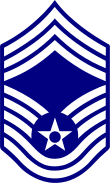- Chief Master Sergeant
-
Chief Master Sergeant (CMSgt) is the ninth, and highest, enlisted rank in the U.S. Air Force, just above Senior Master Sergeant, and is a senior non-commissioned officer. The official term of address is "Chief Master Sergeant" or "Chief".
Attaining the rank of Chief Master Sergeant is the pinnacle of an Air Force enlisted member's career. Some Chief Master Sergeants manage the efforts of all enlisted personnel within their unit or major subsection thereof, while others run major staff functions at higher headquarters levels. All Chief Master Sergeants are expected to serve as mentors for company-grade and field-grade commissioned officers, as well as noncommissioned officers and junior enlisted members, and to serve as advisors to unit commanders and senior officers.
By federal law, only one percent of the Air Force enlisted force may hold the rank of Chief Master Sergeant.
Contents
Special duty positions
First Sergeant
The special duty position of First Sergeant is the senior enlisted advisor to a unit commander. First Sergeants can be of pay grades E-7 to E-9; while they are referred to officially as "First Sergeant" regardless of their pay grade, they are unofficially referred to as "First Shirt", or simply "The Shirt".
Command Chief Master Sergeant
The position of Command Chief Master Sergeant (CCM) was renamed in November 1998. Formerly titled Senior Enlisted Advisor, Command Chief Master Sergeants serve as senior advisors to commanders at Wing, Numbered Air Force (NAF), Field Operating Agency (FOA), and Major Command (MAJCOM) levels. In a Joint command, when an Air Force Chief Master Sergeant fills a DoD-nominative Command Senior Enlisted Leader position (see Note), that individual is also designated as a Command Chief Master Sergeant. Command Chiefs advise the Commander on all enlisted matters, including all issues affecting the command's mission and operations, and the readiness, training, utilization, morale, technical and professional development, and quality of life of all enlisted members in the organization. Command Chiefs are the functional managers for First Sergeants in their entire command/organization.
- NOTE: Joint Command Senior Enlisted Leader (aka Senior Enlisted Advisor) positions are those that require individuals to hold the following ranks: Army Command Sergeant Major (CSM), Marine Corps Sergeant Major (SgtMaj), Navy Command, Force or Fleet Master Chief Petty Officer (CMDCM, FORCM or FLTCM), Air Force Command Chief Master Sergeant (CCM), or Coast Guard Command Master Chief Petty Officer (MCPO). In order to fill Joint DoD-nominative Joint Command Senior Enlisted Leader positions, each military service nominates one individual to the Joint Commander/Director.
Chief Master Sergeant of the Air Force
The post of Chief Master Sergeant of the Air Force (CMSAF) is unique. The Chief Master Sergeant of the Air Force is selected by the Air Force Chief of Staff. The CMSAF is the senior enlisted member in the Air Force, with a 3-star protocol equivalency. The CMSAF represents the entire Air Force enlisted force, and speaks on behalf of the enlisted members of the Air Force to Air Force and DoD senior leadership and, when requested, to Congress. As of 30 June 2009, the current Chief Master Sergeant of the Air Force is CMSgt James A. Roy.
NOTE: The CMSAF is one of six Service Senior Enlisted Leaders. Each of the five U.S. Armed Services has a rank for the senior enlisted member of that service. Only one Soldier, Marine, Sailor, Airman or Coast Guardsman can hold this rank at any one time, although they continue to hold the rank upon retirement. The positions are: Sergeant Major of the Army (SMA), Sergeant Major of the Marine Corps (SgtMajMC), Master Chief Petty Officer of the Navy (MCPON), Chief Master Sergeant of the Air Force (CMSAF), and Master Chief Petty Officer of the Coast Guard (MCPOCG). There is an additional position, senior to the other five, of Senior Enlisted Advisor to the Chairman, who may be a member of any of the five services. The six, while nominally holding pay-grade E-9, receive a special pay rate superior to other E-9s, which is unaffected by the incumbent's longevity.
Historical notes
Although the Air Force had been an independent service since 1947, the rank of Chief Master Sergeant did not come into being until the authorization of the Military Pay Act of 1958. This act established the pay grades of E-8 and E-9, but without specifying titles for those pay grades. It wasn't until late 1958 that the title of Chief Master Sergeant (and the accompanying rank insignia) was decided upon.
The original Chief Master Sergeant rank insignia (1958–1994) consisted of 2 chevrons on top, 3 stripes in the middle, and 3 rockers on bottom.
Until his retirement in 2003, Chief Master Sergeant Norman Marous was the Air Force's most senior Chief Master Sergeant, having served in the Air Force since 1962. Marous left active duty in 1962 to spend 22 years in the USAF Reserve and National Guard before returning to active duty as a Chief Master Sergeant in 1989.
See also
References
- Air Force Instruction , The Enlisted Force Structure
- Technical Sergeant Spink, Barry L. "A Chronology of the Enlisted Rank Chevron of the United States Air Force, 19 February 1992." Air Force Historical Research Agency.
United States enlisted ranks Pay Grade →
Branch of Service ↓E-1 E-2 E-3 E-4 E-5 E-6 E-7 E-8 E-9 Air Force AB Amn A1C SrA SSgt TSgt MSgt SMSgt CMSgt - CCM - CMSAF - SEAC Army PVT PV2 PFC SPC - CPL SGT SSG SFC MSG - 1SG SGM - CSM - SMA - SEAC Marine Corps Pvt PFC LCpl Cpl Sgt SSgt GySgt MSgt - 1stSgt MGySgt - SgtMaj - SgtMajMarCor - SEAC Navy SR SA SN PO3 PO2 PO1 CPO - SEA SCPO - CMDSCPO MCPO - CMDCM - FORCM - FLTCM - MCPON - SEAC Coast Guard SR SA SN PO3 PO2 PO1 CPO SCPO MCPO - CMC - MCPOCG Categories:- Enlisted ranks of the United States Air Force
- United States military enlisted ranks
Wikimedia Foundation. 2010.





